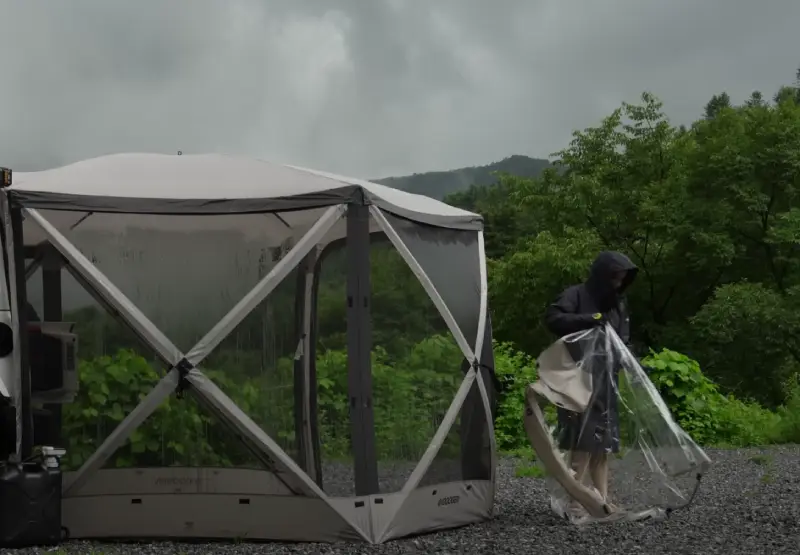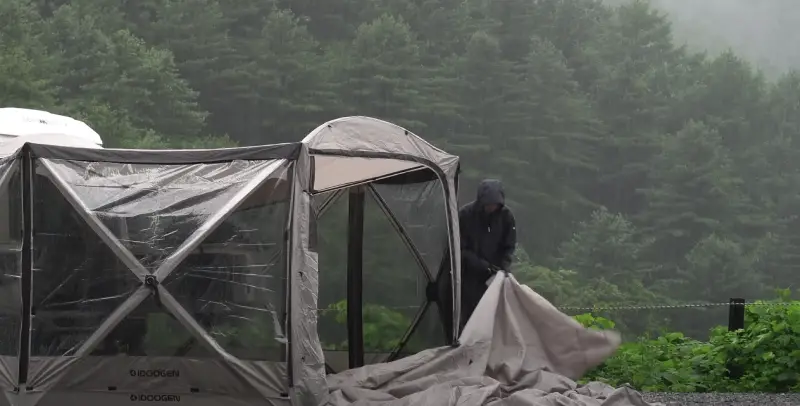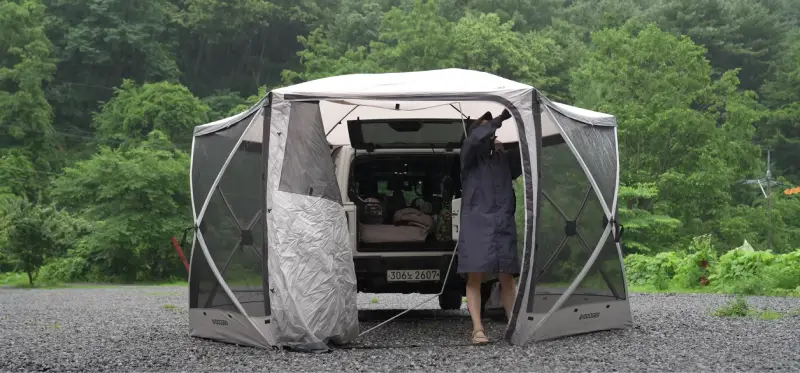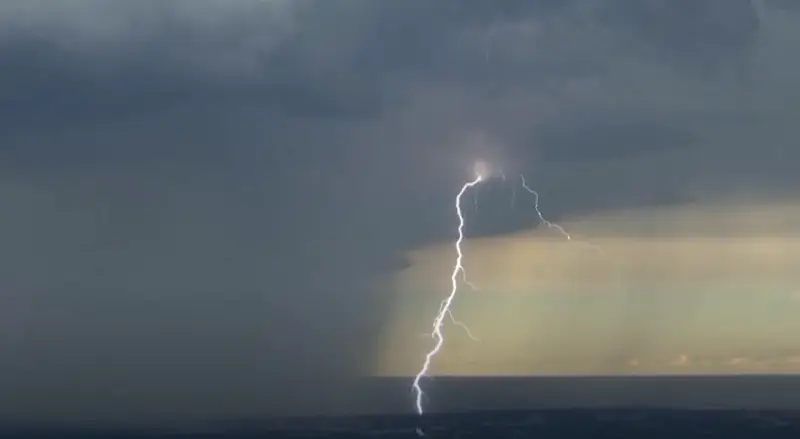Is Camping In A Tent Safe When There’s Lightning: 3 Risks & 7 Preparations
I’ve had the misfortune of getting caught in a few thunderstorms, and let me tell you, it’s far from enjoyable. Lightning’s unpredictability and potential danger make it a force to be reckoned with. For camping during a thunderstorm, the associated risks are worth considering. Storms often bring torrential downpours, strong winds, and, of course, lightning.
I wouldn’t recommend camping in a tent during a lightning storm. Based on my experience as a traveling mother with a baby and a pet, it’s essential to prioritize safety.
Tents offer no protection from lightning, and it’s best to stay away from water, wet items, and metal objects, as they efficiently conduct electricity.
I will share my experiences about camping in a tent safe when there’s lightning with its risk and how to stay safe in a tent during a thunderstorm.
Is Camping In A Tent Safe When There’s Lightning: 3 Risks

I remember the first time I went camping. The excitement of being in the great outdoors was thrilling. But then, a thunderstorm rolled in. I was in my tent and realized I knew little about the risks of camping during a thunderstorm.
- I learned that lightning can strike anywhere, and a tent offers no protection. It’s like being out in the open. If lightning strikes, it could hit the tent and anyone inside. This is a scary thought, especially when you’re in nowhere with no safe buildings nearby.
- I also learned that finding a safe place to take shelter is best. The metal frame of a car or the grounded structure of a building can direct the lightning’s electricity into the ground, keeping those inside safe.
- If no secure buildings or vehicles are nearby, I suggest leaving open fields or elevated places. These locations have a higher probability of being struck by lightning. Tall, standalone trees are also susceptible to lightning strikes.
This experience taught me a lot about thunderstorm risks. I think about it every time I plan a camping trip. I check the weather forecast and have a plan in case a storm rolls in. It’s better to be safe than sorry.
7 Thunderstorm Preparations

As an avid camper and a mother, I’ve had my fair share of thunderstorm experiences. Here are some steps I’ve learned to take while camping during a thunderstorm:
- Choosing the Right Tent: One of the first things I learned was to avoid using a tent with metal poles. Metal can attract lightning; the last thing you want is to be inside a lightning rod during a storm.
- Picking a Safe Spot: I’ve found that choosing a lightning-safe camping spot is crucial. I usually look for a place that’s not the highest point in the area, as lightning strikes the tallest object.
- Staking the Tent for Wind: Thunderstorms often come with strong winds. I always make sure my tent is staked correctly to withstand the wind. It’s saved my tent from being blown away more than once!
- Pre-Storm Preparations: I’ve developed a routine of getting ready before the storm arrives. This includes securing loose items, making sure my emergency kit is accessible, and ensuring my phone is charged.
- Seeking Shelter: If a safe building or vehicle is nearby, I head there as soon as I hear thunder. If not, I stay low and avoid touching the ground as much as possible.
- Insulating from the Ground: I always carry a foam pad to protect myself from the ground. It’s not just for comfort – it can also reduce the risk of ground current if lightning strikes nearby.
- Spreading out in a group: If I’m camping in a large group, we spread out when a storm approaches. This way, if one tent is struck by lightning, others may remain safe.
What To Do During Lightning In A Tent
When it’s too late to leave the tent for a safer place during lightning, there are a few key things to consider. As a traveling mother, I want to share my personal experience and provide some insights on how to stay safe inside a camping tent during a thunderstorm.
I advise you not to touch the tent’s frame or cover. It’s best to stay in the very middle of it. Trust me, it’s safer for everyone involved.
I always avoid touching the tent’s frame or cover during a storm. Instead, I position myself and my little ones in the middle of the tent to minimize any potential risks.
I advise you to reduce the risk of electrocution and sit in a compact, squatted position inside the tent. Keeping contact with the ground limited to one spot prevents step voltage and stays safe.
Staying on the bare ground inside the tent during a storm is best. Using a dry air mattress, your backpack, or a folded camping mat can help enhance insulation and reduce your grounding. Also, remember to keep your hiking boots on for added protection. Remove any wiring leading into the tent to eliminate potential hazards during a storm.
Safety From Lightning In Various Terrains

Over the years, I’ve camped in various terrains, and each presents unique challenges regarding lightning safety.
- Mountains: I recall a camping trip in the mountains where a thunderstorm rolled in unexpectedly. Mountains can be challenging as they’re high and often isolated, making them prime targets for lightning. I learned to descend immediately if I saw a storm approaching. Avoiding solitary trees and shallow caves is vital, as lightning can jump gaps.
- Rolling Hills & Gentle Terrain: On another trip, I was camping in an area with rolling hills. Here, the risk is slightly less than in the mountains but still present. The safest place is in a ravine or a valley, but never under a solitary tree.
- Fields: Camping in open fields can be risky, too. Once, a storm caught me off guard in a large, open area. Making yourself the smallest target possible in such situations is best. I did this by crouching down, keeping my feet together, and minimizing contact with the ground.
- Forests: Forests can offer some protection from lightning, but they come with risks. On one of my forest camping trips, I sought shelter under a dense group of small trees during a storm.
- Water: One of the most dangerous places during a thunderstorm is in or near water, as water conducts electricity. I was once fishing on a lake during a camping trip when a storm approached. I got out of the water and off the beach as quickly as possible, seeking shelter in a low, dense area of trees.
Mastering lightning safety demands a tailored strategy for every terrain. The crux lies in comprehending the hazards, staying updated on weather forecasts, and regularly devising a backup plan. It is vital to remember that no beautiful view or angling location warrants jeopardizing one’s life. Prioritize safety above all else as you embark on your outdoor adventures.
Conclusion
Although camping during a thunderstorm can be thrilling, it is imperative to know the dangers. Prioritizing safety through thoroughly understanding the risks and taking necessary precautions is paramount.
Selecting an appropriate camping location, adequately preparing for the storm, and familiarizing yourself with proper sheltering techniques are crucial to ensure your well-being. These guidelines will help you have a pleasant camping experience while safeguarding yourself during a lightning storm.
FAQs
Should I Leave My Tent During A Thunderstorm?
When thunder and lightning are nearby, it’s essential to prioritize your safety by promptly leaving your tent and seeking refuge in a secure shelter like a building or vehicle. If no suitable cover is available, distance yourself from tall objects, bodies of water, and metal structures. Take precautionary measures by crouching down and protecting your head.


